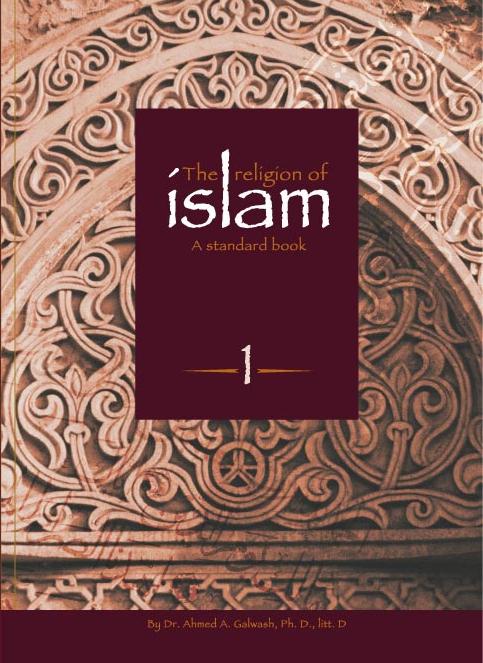The Religion Of Islam vol.1

Their Religion
The religion of the Arabs before Islam was in the main gross idolatry, the Sabian religion or idolatry being the most widely extended among the whole nation, though there were also considerable numbers of Christians, Jews and Magians among them. The Sabians believed in God however, they worshipped also stars and planets and angels as well as images; they honoured them as deities and they begged for their intercession with God. They did not consider the idols to be direct agents, though they offered sacrifices and offerings to them, as well as to God, who was often put off with the lesser portion. Thus when they planted fruit trees, or sowed a field, they divided their cultivation by a line into two parts, setting aside one part for their idols and the other for God; if any of the fruits happened to fall from the idols’ parts, into God’s they made restitution, but if from God’s part into the idols’ they made no restitution. Also when they watered the idol’s land, if the water broke over the channels made for that purpose, and ran on God’s part, they dammed it up again, but if the water ran into the idol’s part they let it run on, saying they (the idols) wanted what was God’s but he wanted nothing. In the same manner, if the offering designed for God happened to be better than that designed for the idols, they made an exchange, but not otherwise. It was from this gross idolatry or worship of inferior deities or “the companions of God” as the Arabs used to call them, that the Prophet Mohammed reclaimed his nation by establishing among them the undivided worship of the true God.[1]
There were seen celebrated temples, dedicated to the seven planets, adored by the whole nation, though each tribe had chosen one planet as the peculiar object of its worship. The tribe of Himyar worshipped in general the sun, the tribe of Misam the Bull’s eye the tribes of Lakhm and Joham, Jupiter, the tribe of Keis, Sirius or the Dog star, that of Assad, Mercury, the tribe of Tay worshipped Canopus, while the temple of Mecca was dedicated to Sturn. For the worship of angels and intelligences there were other celebrated, peculiar idols, ten of which are mentioned in the Koran; they are: Al Lat, Al-Uzza and Manata which were called ‘Goddesses’ and ‘Daughters of God. Al Lat was the idol of the tribe of Thakif, Al-Uzza was the deity of Ghatfan; Manata was the favourite idol of Kuzaah and Huzail. There were two other celebrate idols, namely Al Jibt and Taghout which are also referred to in the Koran. They were of the chief idols of the tribe of Koreish. Special mention is also made in the Koran of five idols, namely Wadd, Suwaa, Yagoutha, Yauka and Nassra. These were common idols among the pagan Arabians besides the idols referred to above the Arabs worshipped a great number of other. Almost every housekeeper had his household god. There was a famous idol called Hobbal, which was supposed by the Arabs to supply them with rain, a very important consideration in their dry land. Therefore, it was an object of common worship among them. It had by accident lost a hand, which the Koreish repaired with one of gold. A great number of idols were no more than large rude stones, the worship of which was first introduced by the prosperity of Ishmael; for when they increased in number and the territory of Mecca grew too narrow for them, large numbers of them emigrated to other localities. It was usual for them on such emigrations to take with them some of the stones of the revered Holy Land of Mecca, and to set them up in their new abodes and to pay them devotion. But this devotion ended at last in rank idolatry; the Ishmaelites forgetting the religion of their fathers so far as to pay divine worship to rude pieces of stone. As to the worship of the stars, the Arabs might be easily led into it from their observing the changes of weather happening at the rising and setting of certain of them which after a long course of experience induced them to ascribe a divine power to those stars, and to think themselves indebted to them for their rain; they used to say that their rain came from such or such a star. The Koran particularly takes notices of this superstition.
Magian religion or fire–worship, was introduced by the Persian Zoroastrians through their frequent intercourse with the Arabs.
Judaism was introduced among the idolatrous Arabs by the Jews who fled in great numbers into Arabia from the fearful destruction of their country by the Romans. They made proselytes among several tribes and in time became very powerful, and possessed of several towns and fortresses in the Arabian Peninsula. But over a century at least before, the Jewish religion was not unknown to the Arabs. Abu Carb Assab who was king of Yemen about 700 years before Islam, is said to have introduced Judaism among the idolatrous Himyarties. Some of his successors also embraced the same religion, one of whom, Youssef, surnamed Zul Nowas, was remarkable for his zeal and terrible persecution of all who would not turn Jew, putting them to death by various tortures, the most common of which was throwing them into a glowing pit of fire whence he acquired the sinister title of “Lord of the Pit”. This persecution is also referred to in the Koran.[2]
Christianity had likewise made good progress among the Arabs before Islam. The persecutions and disorders which darkened the eastern church soon after the beginning of the third century, obliged great numbers of Christians to seek shelter in Arabia, that country of liberty. These were for the most part of the Jacobite community, a sect that was widely distributed throughout Egypt, Arabia and Mesopotamia.
The above mentioned were the principal religions that prevailed among the Arabs, though the chief religion was gross idolatry. Some of the pagan Arabs believed neither in a creation of Divine origin nor in a resurrection, attributing the existence of things and their dissolution to nature.
Some believed that when the soul separated itself from the body, it took the shape of a bird, called ‘ Hama’ or ‘Sada’. If the deceased person was the victim of violent death, the bird remained hovering over the grave crying ‘Iskouni’ i.e., “Give me drink”, till his death was avenged and then it flew away. This belief was forbidden by the Koran. Belief in Spirits and Fairies and Oracles rendered by their idols whom they consulted by means of headless arrows which they called ‘Azlam’ was universal. Each tribe had its particular idols and particular temples. The hierophants attending these temples received rich offerings from the devotees and often there arose sanguinary conflicts among the worshippers of different temples. But the celebrated temple of the Kaaba at Mecca, the Chapel of Abraham and Ishmael, was considered sacred by all. The Jews and Sabians sent offerings there. The custody of the Kaaba was the object of great jealousy among the tribes, as it conferred on the custodians the most honourable functions and privileges. At the time of the birth of Mohammed the custody of the Kaaba was in the hands of his family, the Hashimites.
As for the Christian religion at the advent of Mohammed, though it flourished and had a large number of followers among the Arabs, its true and pure doctrines were exceedingly and abominably corrupted.[3] Some of the Christians believed the soul died with the body, and was to be raised again with it on the last day. Others substituted the Virgin Mary for God or worshipped her as such. These who believed in the divinity of the Virgin Mary were named the Mariamites.[4] This conception is condemned in the Koran.
Reviewing the religious aspect of the Arabs before Islam, Sir William Muir says: “After five centuries of Christian Evangelization, we can point to put a sprinkling here and there of Christians; the Bau Harith of Najran, the Banu Hanifa of Tamama, some of Banu Tay of Tayma and hardly any more. Judaism, vastly more powerful had exhibited a spasmodic effort of proselytism under Zul Nowas, but as an active and converting agent, the Jewish faith was no longer operative. In fine, viewed thus in a religious aspect, the surface of Arabia had been now and then gently rippled by the feeble efforts of Christianity, the sterner influences of Judaism had been occasionally visible in deeper and more troubled current from every quarter with an unbroken and unebbing surge towards the Kaaba, gave ample evidence that the faith and worship of Mecca held the Arab mind in a thralldom vigorous and undisputed.[5]
